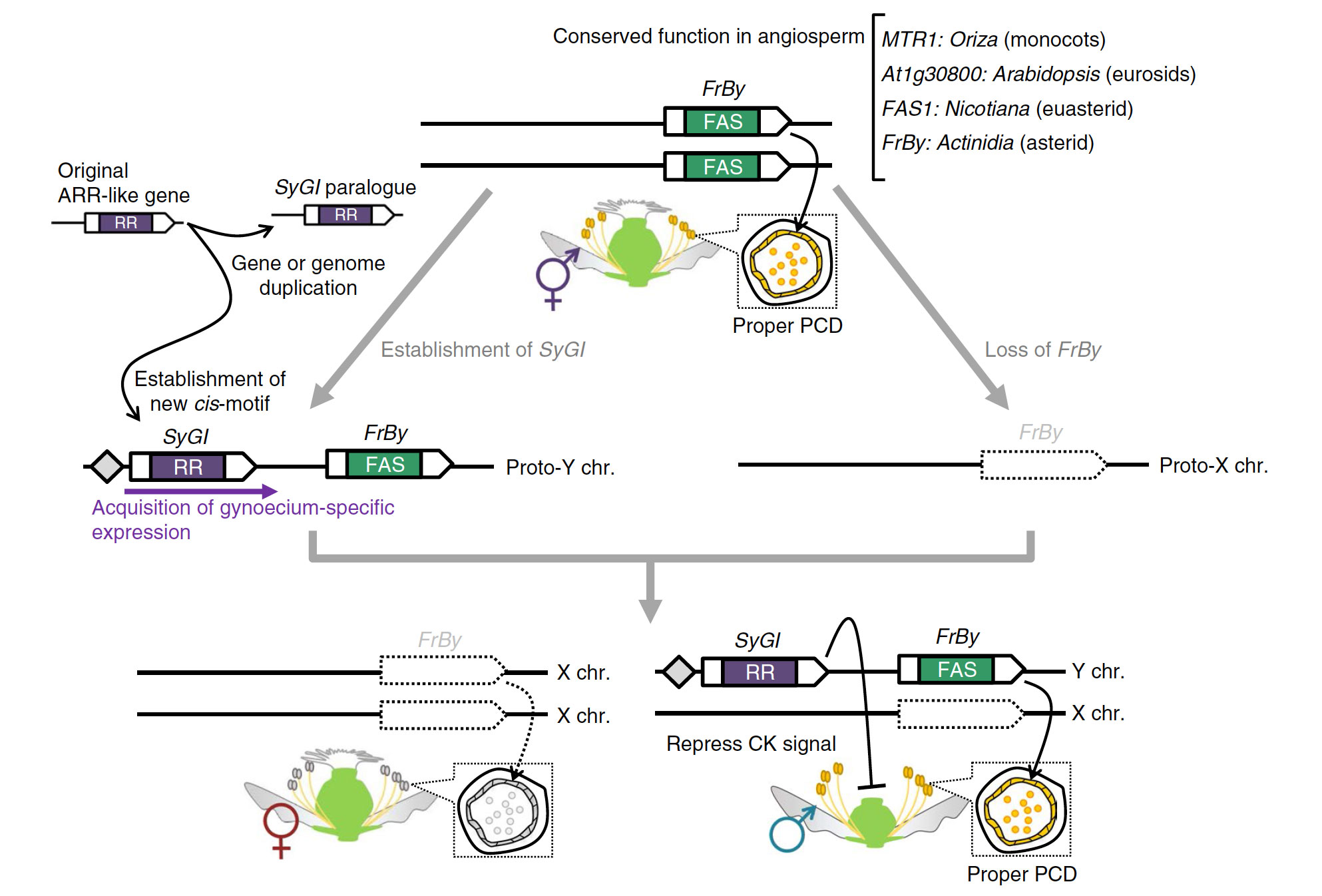博文
Nature Plants:两个Y染色体编码基因控制猕猴桃的性别决定
||
Two Y-chromosome-encoded genes determine sex in kiwifruit
First author: Takashi Akagi; Affiliations: Kyoto University (日本京都大学): Kyoto, Japan
Corresponding author: Takashi Akagi
Dioecy, the presence of male and female individuals, has evolved independently in multiple flowering plant lineages. Although theoretical models for the evolution of dioecy, such as the ‘two-mutations’ model, are well established, little is known about the specific genes determining sex and their evolutionary history. Kiwifruit, a major tree crop consumed worldwide, is a dioecious species. In kiwifruit we previously identified a Y-encoded sex-determinant candidate gene acting as the suppressor of feminization (SuF), named Shy Girl (SyGI). Here, we identify a second Y-encoded sex-determinant that we named Friendly Boy (FrBy), which exhibits strong expression in tapetal cells. Gene-editing and complementation analyses in Arabidopsis thaliana and Nicotiana tabacum indicated that FrBy acts for the maintenance of male (M) functions, independently of SyGI, and that these functions are conserved across angiosperm species. We further characterized the genomic architecture of the small (<1 megabase pairs (Mb)) male-specific region of the Y chromosome (MSY), which harbours only two genes expressed extensively in developing gynoecia and androecia, respectively: SyGI and FrBy. Re-sequencing of the genome of a natural hermaphrodite kiwifruit revealed that this individual is genetically male but carries deletion(s) of parts of the Y chromosome, including SyGI. Additionally, expression of FrBy in female kiwifruit resulted in hermaphrodite plants. These results clearly indicate that Y-encoded SyGI and FrBy act independently as the SuF and M factors in kiwifruit, respectively, and provide insight into not only the evolutionary path leading to a two-factor sex-determination system, but also a new breeding approach for dioecious species.

雌雄异株,即植物的雌性、雄性分为不同的个体,在多个有花植物支系中独立演化。尽管对于雌雄异株的演化已经有了很好的理论模型,比如双突变模型,但具体是哪个基因决定着植物的性别分化及其演化历史还不清楚。猕猴桃是全球范围上比较主要的树木类消费作物,并且是雌雄异株的树种。在猕猴桃中,作者在之前的研究中鉴定到了Y染色体上编码的一个雌性抑制基因,并命名为“害羞女孩”SyGI。本文中,作者再次鉴定到了Y染色体上编码的另外一个控制猕猴桃性别决定的基因,并且命名为“友好男孩”FrBy,其在绒毡层细胞中存在比较强的表达。在拟南芥和烟草中的基因编辑和互补试验显示FrBy基因作用于雄性的维持,且独立于SyGI基因,说明该基因的功能在不同被子植物物种中比较保守。作者进一步研究了约1Mb的雄性特异性Y染色体区域,该区域仅有两个基因SyGI和FrBy分别在发育中的雌蕊和雄蕊中广泛表达。对于一个天然两性猕猴桃群落的基因组重测序分析显示该群落中的个体应该是雄性的,但其Y染色体上部分区域缺失,缺失的区域包括了SyGI基因。另外,在雌性猕猴桃中表达FrBy基因能够获得两性猕猴桃。本文的研究结果清晰地揭示了雌雄异株植物猕猴桃中,Y染色体上两个编码基因SyGI和FrBy分别作为SuF和M因子,相互独立发挥作用。作者的研究不仅为现有的植物双因素性别决定系统的演化历史提供了新的视野,同时也为雌雄异株植物的育种提供了新的方法。
通讯:Takashi Akagi (https://www.hakubi.kyoto-u.ac.jp/eng/02_mem/02akagi.shtml)
研究方向:利用基因组学等手段对水果作物进行遗传改良。
doi: https://doi.org/10.1038/s41477-019-0489-6
Journal: Nature Plants
Published date: August 05, 2019

https://blog.sciencenet.cn/blog-3158122-1192780.html
上一篇:Nature Communications:植物母体组织通过赤霉素信号控制胚柄的细胞程序性死亡
下一篇:PNAS:黄瓜顶端优势建立的遗传基础
全部作者的其他最新博文
- • Plant Physiology:CsMADS3促进柑果中的叶绿素降解和类胡萝卜素合成(华中农业大学)
- • Molecular Plant:LBD11-ROS反馈调节作用于拟南芥的维管形成层增殖和次生生长(浦项科技大学)
- • Science Advances:根结线虫通过调控植物的CLE3-CLV1模块,促进侵染进程(日本熊本大学)
- • Nature Communications:油菜素内酯参与植物营养生长期转变的分子机制解析(浙江农林大学)
- • Current Biology:光合作用产生的蔗糖驱动侧根“生物钟”(德国弗莱堡大学)
- • PNAS:花同源异型基因在叶中被抑制、花中被激活的分子机制(南卡罗来纳大学)